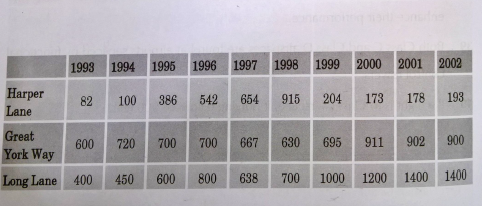
The table shows the average number of vehicles using three roads from 1993 to 2002.
Between 1993 and 1998, the average number of cars using Harper Lane climbed from just under an average of 100 vehicles per hour to over 900: a nine-fold increase. Great York Way saw barely any increase in traffic, increasing from an hourly rate of 600 vehicles to around 700. The traffic travelling down Long Lane increased by 75% in the same period, from 400 to 700 vehicles.
After the traffic calming was introduced in Harper Lane at the beginning of 1999, the volume of traffic fell dramatically to an hourly average of 204 cars, considerably fewer than in 1998. Thereafter, the number of cars stabilized at just below the 1999 level and Long Lane witnessed a significant increase in vehicle numbers with the hourly average soaring to 1,400 in 2002. As regards Great York Way, numbers rose, but much less significantly, reaching around 900 vehicles in 1999 and hovering at this level till the year 2002.